


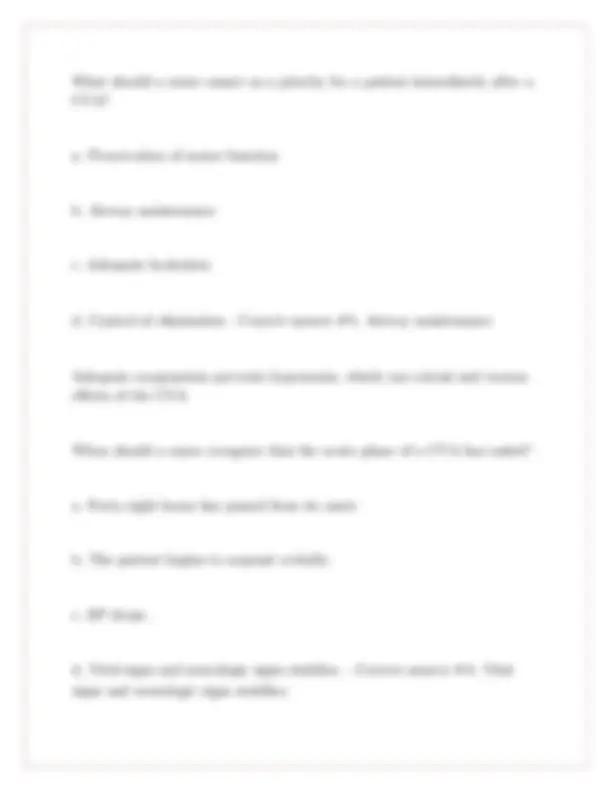


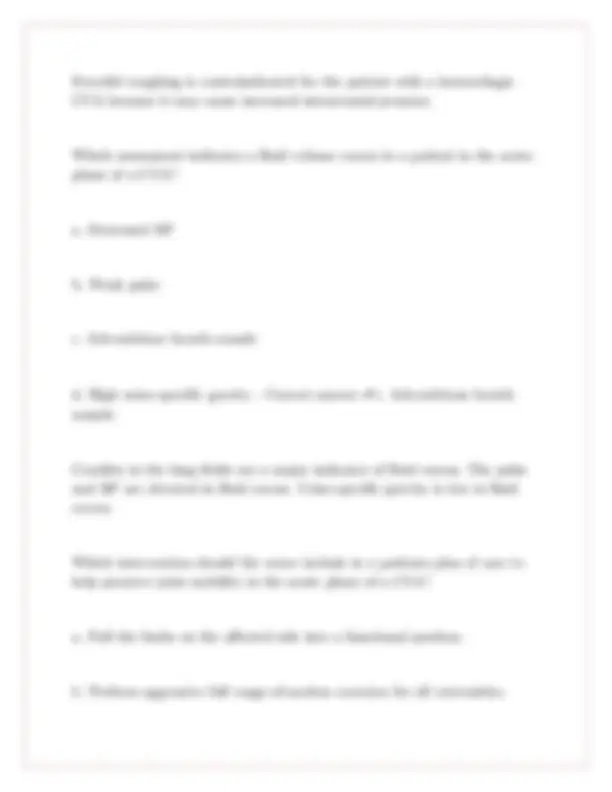








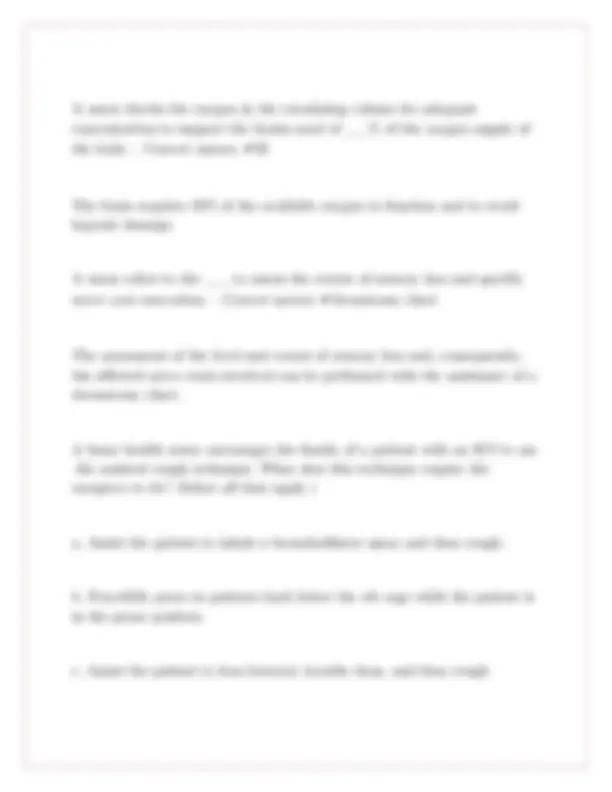

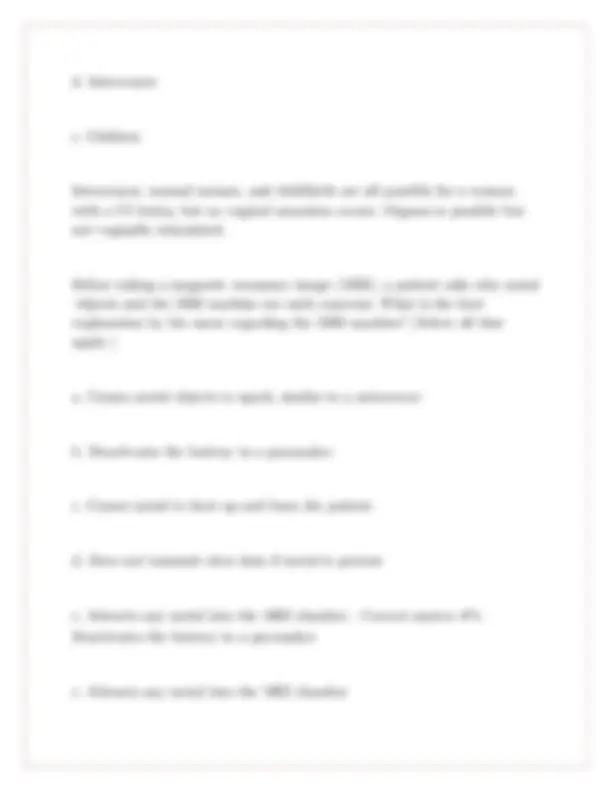






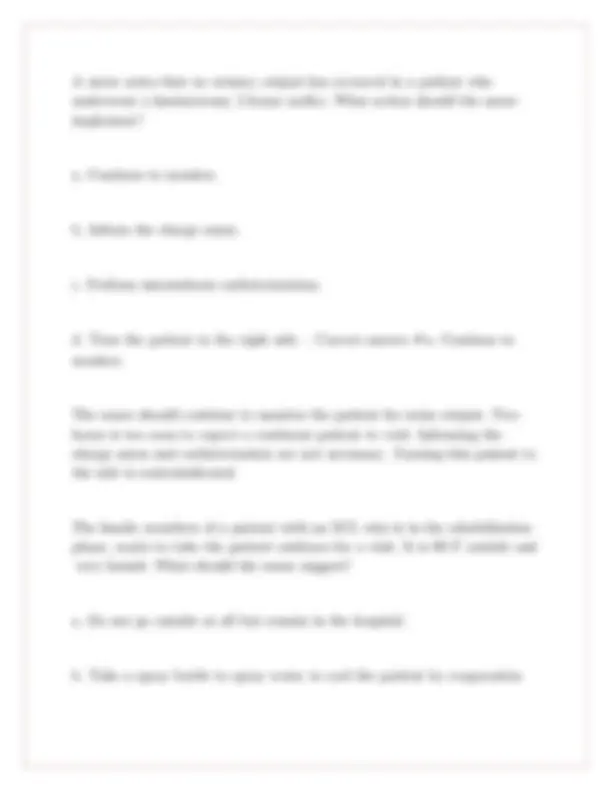





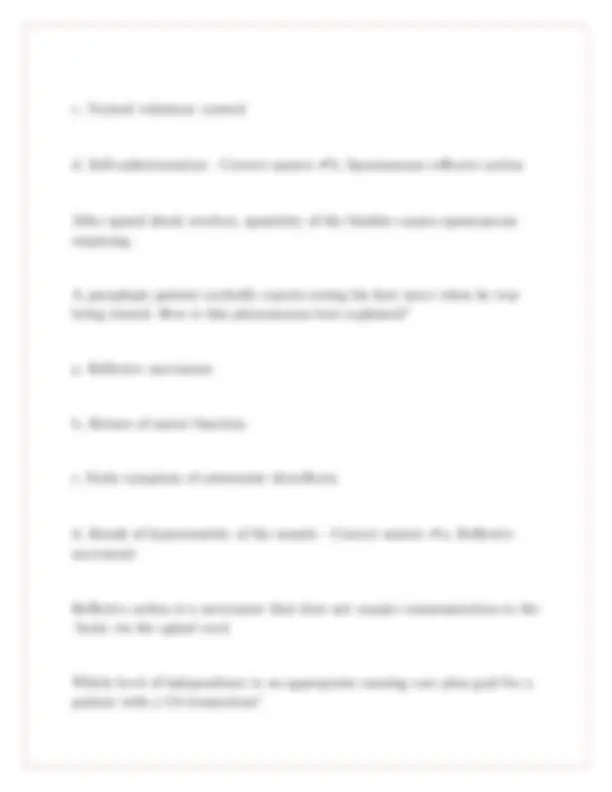

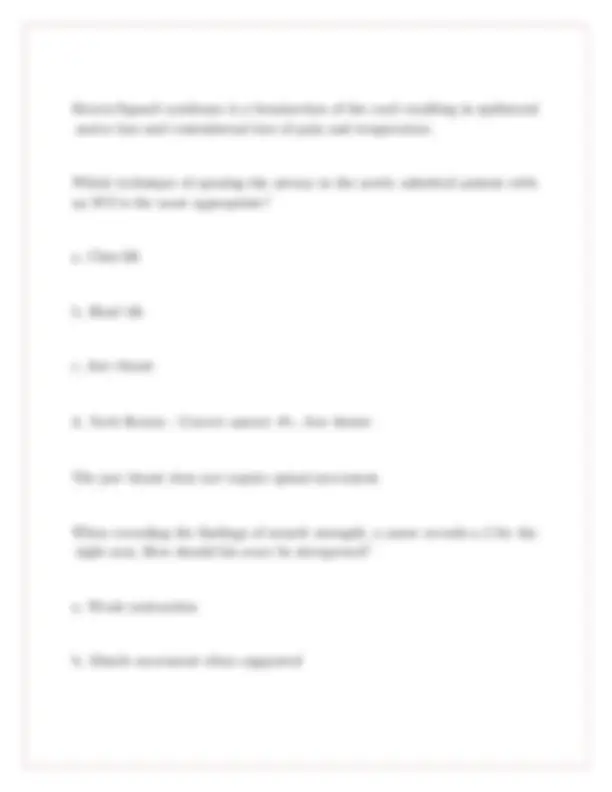


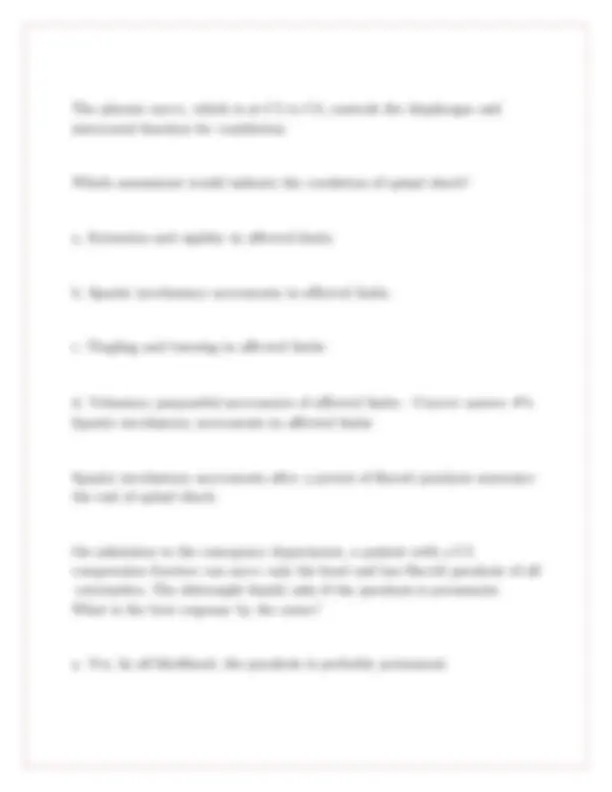


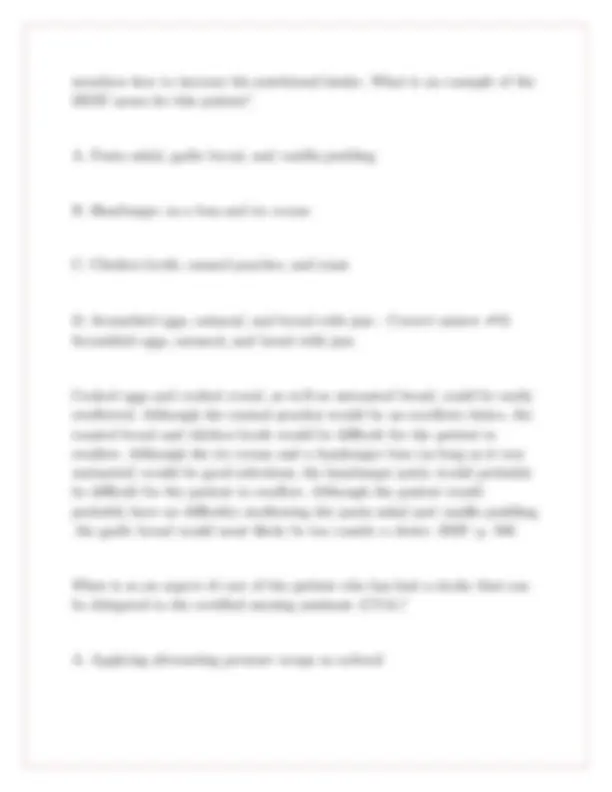


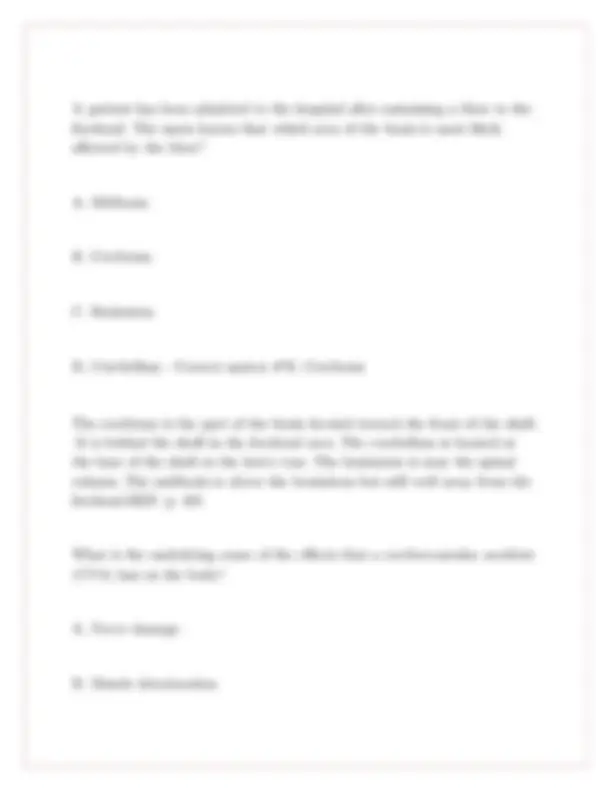






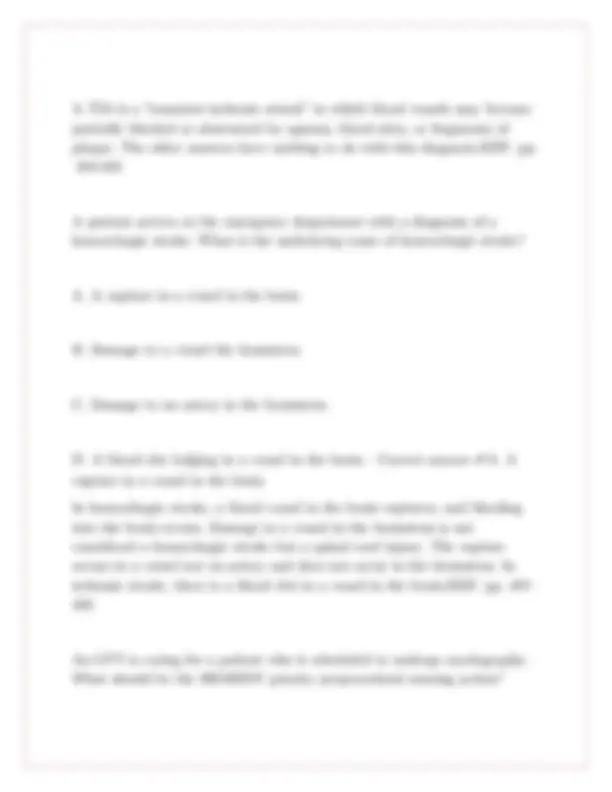

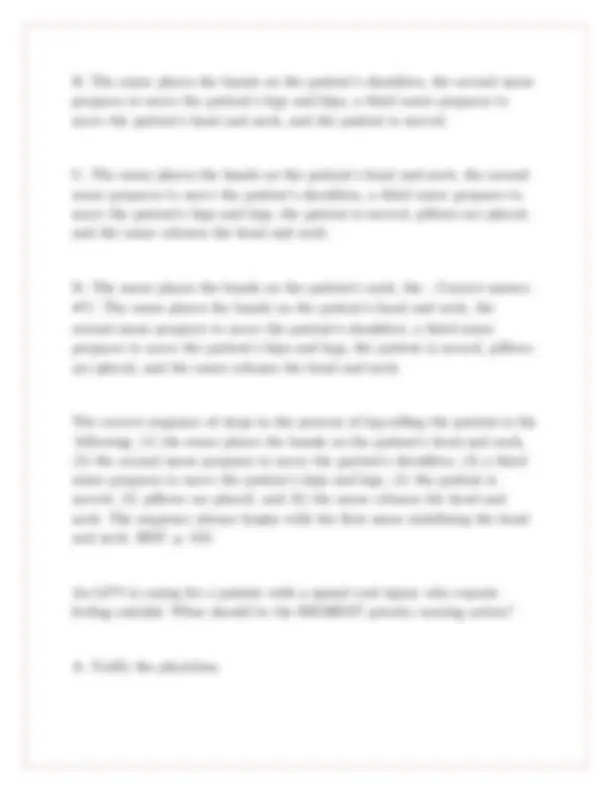
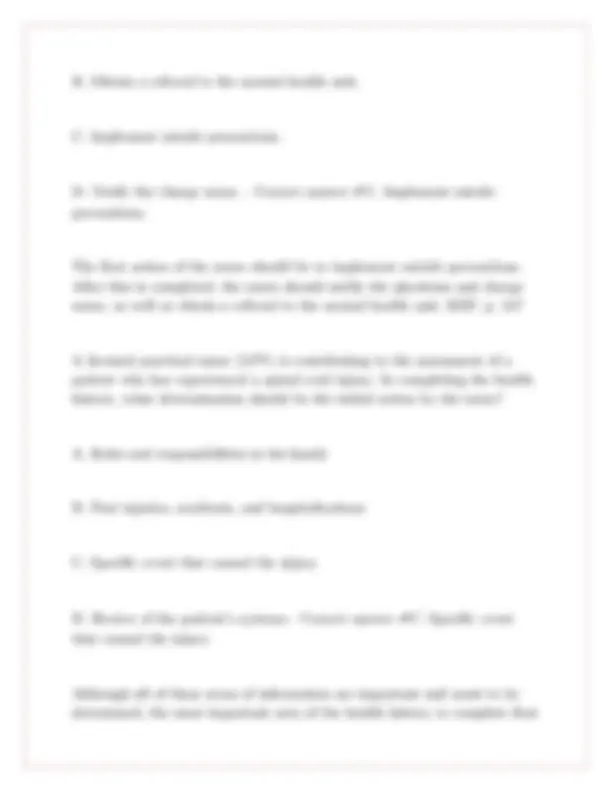


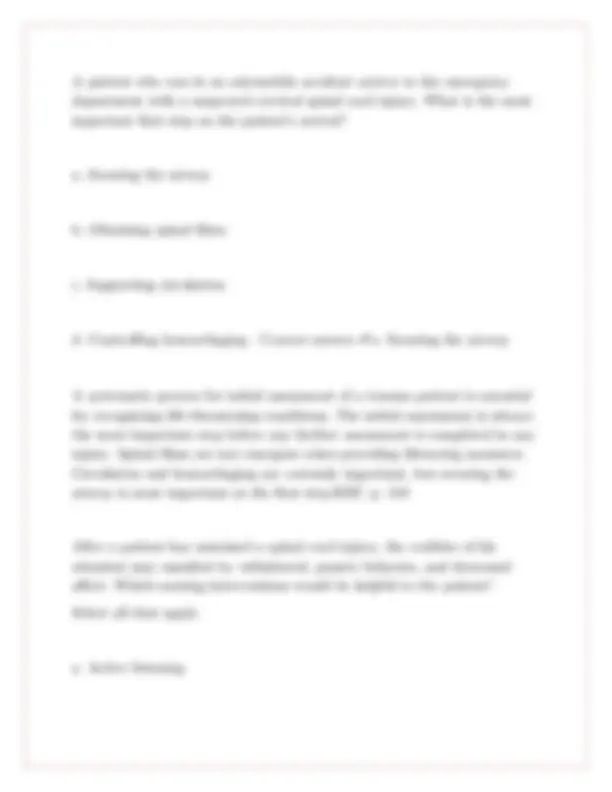










Study with the several resources on Docsity

Earn points by helping other students or get them with a premium plan


Prepare for your exams
Study with the several resources on Docsity

Earn points to download
Earn points by helping other students or get them with a premium plan
Community
Ask the community for help and clear up your study doubts
Discover the best universities in your country according to Docsity users
Free resources
Download our free guides on studying techniques, anxiety management strategies, and thesis advice from Docsity tutors
Quiz 9 MS 2 CVA and spinal cord injury Exam with precise answers & rationales
Typology: Exams
1 / 70

This page cannot be seen from the preview
Don't miss anything!































































A |! patient |! has |! weakness |! on |! the |! right |! side |! and |! impaired |! reasoning |! after |! having |! a |! cerebrovascular |! accident |! (CVA). |! What |! part |! of |! the |! brain |! is |! affected? a. |! Left |! hemisphere |! of |! the |! cerebrum b. |! Right |! hemisphere |! of |! the |! cerebrum c. |! Left |! cerebellum d. |! Right |! cerebellum |! - |! Correct |! answer |! ✔a. |! Left |! hemisphere |! of |! the |! cerebrum Impaired |! motor |! strength |! on |! the |! right |! side |! in |! conjunction |! with |! impaired |! reasoning |! indicates |! a |! lesion |! in |! the |! left |! hemisphere |! of |! the |! cerebrum. |! The |! cerebellum |! controls |! balance |! and |! is |! not |! contralateral. Which |! patient |! is |! at |! the |! greatest |! risk |! for |! a |! CVA?
a. |! A |! 20-year-old |! obese |! Latin |! woman |! who |! is |! taking |! birth |! control |! pills b. |! A |! 40-year-old |! athletic |! white |! man |! with |! a |! family |! history |! of |! CVA c. |! A |! 60-year-old |! Asian |! woman |! who |! smokes |! occasionally d. |! A |! 65-year-old |! African |! American |! man |! with |! hypertension |! - |! Correct |! answer |! ✔d. |! A |! 65-year-old |! African |! American |! man |! with |! hypertension Older |! African |! Americans |! have |! a |! higher |! incidence |! of |! CVA |! than |! occasional |! smokers, |! young |! persons, |! or |! athletes. |! Hypertension |! increases |! the |! risk. A |! patient |! experienced |! a |! period |! of |! momentary |! confusion, |! dizziness, |! and |! slurred |! speech |! but |! recovered |! in |! 2 |! hours. |! Which |! assessment |! in |! the |! diagnosis |! of |! this |! episode |! would |! be |! most |! helpful? a. |! Patients |! complaint |! of |! nausea b. |! Blood |! pressure |! (BP) |! of |! 140/90 |! mm |! Hg c. |! Patients |! complaint |! of |! headache d. |! Auscultation |! of |! a |! bruit |! over |! the |! carotid |! artery |! - |! Correct |! answer |! ✔d. |! Auscultation |! of |! a |! bruit |! over |! the |! carotid |! artery
c. |! Dilates |! the |! vessels |! to |! improve |! blood |! flow. d. |! Suppresses |! the |! formation |! of |! platelets. |! - |! Correct |! answer |! ✔b. |! Prevents |! the |! formation |! of |! new |! clots. Coumadin |! and |! heparin |! prevent |! more |! clots |! rather |! than |! dissolving |! them. |! Coumadin |! has |! no |! effect |! on |! vasodilation |! or |! blood |! cell |! production. A |! patient |! has |! had |! a |! complete |! stroke |! as |! a |! result |! of |! a |! ruptured |! vessel |! in |! the |! left |! hemisphere. |! How |! should |! this |! patients |! CVA |! be |! classified? a. |! Ischemic, |! embolic b. |! Hemorrhagic, |! subarachnoid c. |! Hemorrhagic, |! intracerebral d. |! Ischemic, |! thrombotic |! - |! Correct |! answer |! ✔c. |! Hemorrhagic, |! intracerebral A |! ruptured |! vessel |! in |! a |! hemisphere |! is |! an |! intracerebral |! hemorrhagic |! CVA. |! It |! did |! not |! occur |! in |! the |! subarachnoid |! space. |! Ischemic |! CVAs |! are |! the |! result |! of |! occluded |! vessels.
What |! should |! a |! nurse |! ensure |! as |! a |! priority |! for |! a |! patient |! immediately |! after |! a |! CVA? a. |! Preservation |! of |! motor |! function b. |! Airway |! maintenance c. |! Adequate |! hydration d. |! Control |! of |! elimination |! - |! Correct |! answer |! ✔b. |! Airway |! maintenance Adequate |! oxygenation |! prevents |! hypoxemia, |! which |! can |! extend |! and |! worsen |! effects |! of |! the |! CVA. When |! should |! a |! nurse |! recognize |! that |! the |! acute |! phase |! of |! a |! CVA |! has |! ended? a. |! Forty-eight |! hours |! has |! passed |! from |! its |! onset. b. |! The |! patient |! begins |! to |! respond |! verbally. c. |! BP |! drops. d. |! Vital |! signs |! and |! neurologic |! signs |! stabilize. |! - |! Correct |! answer |! ✔d. |! Vital |! signs |! and |! neurologic |! signs |! stabilize.
a. |! 3 b. |! 5 c. |! 10 d. |! 24 |! - |! Correct |! answer |! ✔a. |! 3 tPA |! is |! to |! be |! given |! within |! 3 |! hours |! of |! the |! onset |! of |! symptoms |! per |! the |! U.S. |! Food |! and |! Drug |! Administrations |! guidelines. |! In |! some |! special |! treatment |! centers |! this |! drug |! is |! given |! intravenously |! up |! to |! 6 |! hours |! after |! the |! stroke. A |! nurse |! explains |! that |! a |! lumbar |! puncture |! is |! most |! helpful |! as |! a |! diagnostic |! tool |! for |! a |! new |! patient |! who |! has |! had |! a |! CVA. |! What |! would |! this |! diagnostic |! test |! help |! determine |! regarding |! the |! stroke? a. |! It |! is |! lacunar. b. |! It |! is |! hemorrhagic |! or |! embolic. c. |! It |! is |! complete |! or |! in |! evolution. d. |! It |! will |! result |! in |! paralysis. |! - |! Correct |! answer |! ✔b. |! It |! is |! hemorrhagic |! or |! embolic.
Blood |! in |! the |! spinal |! fluid |! indicates |! a |! hemorrhagic |! stroke |! and |! will |! help |! direct |! medical |! protocol |! in |! the |! subsequent |! treatment. A |! patient |! who |! has |! sustained |! a |! hemorrhagic |! stroke |! is |! placed |! on |! a |! protocol |! of |! 60 |! mg |! of |! calcium |! channel |! blocker |! (nimodipine) |! every |! 4 |! hours. |! The |! patients |! pulse |! is |! 82 |! beats/min |! before |! the |! administration |! of |! the |! prescribed |! dose. |! Which |! action |! should |! the |! nurse |! implement? a. |! Give |! the |! full |! dose |! as |! prescribed |! without |! further |! assessment. b. |! Omit |! the |! dose, |! recording |! the |! pulse |! rate |! as |! the |! rationale. c. |! Delay |! the |! dose |! until |! the |! pulse |! is |! below |! 60 |! beats/min. d. |! Give |! half |! of |! the |! prescribed |! dose |! (30 |! mg). |! - |! Correct |! answer |! ✔a. |! Give |! the |! full |! dose |! as |! prescribed |! without |! further |! assessment. The |! dose |! should |! be |! given; |! it |! would |! be |! held |! only |! if |! the |! pulse |! is |! below |! 60 |! beats/min. |! Assessments |! should |! be |! made |! regarding |! BP, |! urine |! output, |! and |! edema. During |! the |! acute |! CVA |! phase, |! a |! risk |! for |! falls |! related |! to |! paralysis |! is |! present. |! Which |! intervention |! best |! protects |! the |! patient |! from |! injury? a. |! Keep |! the |! bed |! in |! a |! high |! position |! for |! ease |! of |! nursing |! care.
Forceful |! coughing |! is |! contraindicated |! for |! the |! patient |! with |! a |! hemorrhagic |! CVA |! because |! it |! may |! cause |! increased |! intracranial |! pressure. Which |! assessment |! indicates |! a |! fluid |! volume |! excess |! in |! a |! patient |! in |! the |! acute |! phase |! of |! a |! CVA? a. |! Decreased |! BP b. |! Weak |! pulse c. |! Adventitious |! breath |! sounds d. |! High |! urine-specific |! gravity |! - |! Correct |! answer |! ✔c. |! Adventitious |! breath |! sounds Crackles |! in |! the |! lung |! fields |! are |! a |! major |! indicator |! of |! fluid |! excess. |! The |! pulse |! and |! BP |! are |! elevated |! in |! fluid |! excess. |! Urine-specific |! gravity |! is |! low |! in |! fluid |! excess. Which |! intervention |! should |! the |! nurse |! include |! in |! a |! patients |! plan |! of |! care |! to |! help |! preserve |! joint |! mobility |! in |! the |! acute |! phase |! of |! a |! CVA? a. |! Pull |! the |! limbs |! on |! the |! affected |! side |! into |! a |! functional |! position. b. |! Perform |! aggressive |! full |! range-of-motion |! exercises |! for |! all |! extremities.
c. |! Support |! affected |! points |! in |! good |! functional |! alignment. d. |! Exercise |! the |! limbs |! every |! 8 |! hours. |! - |! Correct |! answer |! ✔c. |! Support |! affected |! points |! in |! good |! functional |! alignment. Limbs |! maintained |! in |! a |! functional |! anatomic |! position |! and |! gently |! exercised |! (never |! pulled) |! into |! an |! acceptable |! range |! of |! motion |! several |! times |! during |! a |! shift |! will |! maintain |! optimal |! mobility. A |! patient |! in |! the |! acute |! phase |! of |! an |! embolic |! CVA |! has |! an |! order |! for |! 400 |! units |! of |! heparin |! per |! hour |! IV. |! The |! heparin |! is |! in |! a |! solution |! of |! 5000 |! units/100 |! mL |! normal |! saline |! (NS). |! The |! nurse |! should |! set |! the |! electronic |! IV |! monitor |! at |! how |! many |! milliliters |! per |! hour? a. |! 6 b. |! 8 c. |! 10 d. |! 16 |! - |! Correct |! answer |! ✔b. |! 8 Regardless |! of |! the |! method |! of |! calculation, |! 50 |! units |! of |! heparin |! are |! in |! each |! milliliter |! of |! the |! solution; |! 8 |! mL/hr |! delivers |! 400 |! units |! (5000 |! units |! 100 |! mL |! NS |! = |! 50 |! units/mL. |! 400 |! units |! 50 |! units/mL |! = |! 8 |! mL).
c. |! Direct |! front d. |! Either |! side |! - |! Correct |! answer |! ✔b. |! Affected |! side Making |! the |! patient |! scan |! the |! affected |! side |! helps |! stimulate |! the |! return |! of |! normal |! function |! in |! the |! rehabilitation |! phase. Which |! outcome |! criterion |! is |! the |! most |! appropriate |! for |! a |! patient |! with |! Imbalanced |! nutrition, |! related |! to |! dysphagia, |! with |! the |! goal |! of |! adequate |! nutrition? a. |! Offers |! a |! variety |! of |! food |! groups b. |! Eats |! half |! of |! all |! meals |! offered c. |! Maintains |! body |! weight |! of |! 150 |! to |! 155 |! lb d. |! Eats |! all |! meals |! independently |! - |! Correct |! answer |! ✔c. |! Maintains |! body |! weight |! of |! 150 |! to |! 155 |! lb The |! maintenance |! of |! a |! desired |! weight |! is |! indicative |! of |! adequate |! nutrition. |! Eating |! a |! portion |! of |! a |! meal |! or |! eating |! independently |! does |! not |! adequately |! measure |! the |! extent |! to |! which |! the |! goal |! was |! met. |! Offering |! a |! variety |! of |! foods |! is |! a |! nursing |! or |! dietary |! function, |! not |! an |! outcome.
Which |! is |! the |! most |! effective |! intervention |! for |! best |! support |! of |! regular |! bowel |! elimination |! and |! the |! prevention |! of |! constipation? a. |! Limit |! fluid |! intake |! from |! 32 |! to |! 50 |! oz |! daily |! to |! compact |! the |! stool. b. |! Administer |! small |! soapsuds |! enema |! every |! other |! day |! to |! cleanse |! the |! bowel. c. |! Give |! stool |! softeners |! daily, |! establishing |! a |! consistent |! time |! to |! attempt |! elimination. d. |! Administer |! a |! strong |! laxative |! on |! a |! daily |! basis |! to |! encourage |! evacuation. |! - |! Correct |! answer |! ✔c. |! Give |! stool |! softeners |! daily, |! establishing |! a |! consistent |! time |! to |! attempt |! elimination. Daily |! stool |! softeners, |! rather |! than |! daily |! laxatives |! or |! frequent |! enemas, |! help |! restore |! regularity |! and |! bowel |! tone. A |! patient |! in |! the |! rehabilitation |! phase |! after |! a |! CVA |! accidentally |! knocks |! the |! adapted |! plate |! from |! the |! table |! and |! bursts |! into |! tears |! after |! failing |! to |! feed |! himself. |! What |! is |! the |! best |! response |! by |! the |! nurse? a. |! Dont |! cry. |! Youll |! be |! mastering |! eating |! in |! no |! time. b. |! I |! dont |! believe |! crying |! will |! help. |! Lets |! try |! drinking |! from |! a |! special |! cup. c. |! Bless |! your |! heart! |! Let |! me |! get |! a |! new |! meal |! and |! feed |! you.
Which |! posthospital |! option |! should |! the |! nurse |! encourage |! a |! patient |! to |! do |! when |! recovering |! from |! a |! CVA |! to |! provide |! the |! most |! comprehensive |! assistance? a. |! Transfer |! to |! a |! rehabilitation |! center. b. |! Discharge |! to |! home |! with |! scheduled |! visits |! from |! home |! health |! care |! nurses. c. |! Discharge |! to |! home |! with |! scheduled |! visits |! from |! a |! physical |! therapist. d. |! Discharge |! to |! home |! with |! scheduled |! visits |! from |! an |! occupational |! therapist. |!
c. |! Immobility d. |! Stress |! - |! Correct |! answer |! ✔d. |! Stress Hyperglycemia |! occurs |! after |! a |! CVA |! as |! the |! bodys |! response |! to |! stress. |! If |! left |! untreated, |! the |! hyperglycemia |! will |! cause |! increased |! brain |! damage |! and |! worsen |! the |! outcome |! of |! the |! stroke. Which |! transitory |! symptoms |! might |! occur |! when |! a |! patient |! is |! diagnosed |! with |! a |! TIA? |! (Select |! all |! that |! apply.) a. |! Incontinence b. |! Dysphagia c. |! Ptosis d. |! Tinnitus e. |! Dysarthria |! - |! Correct |! answer |! ✔b. |! Dysphagia c. |! Ptosis d. |! Tinnitus
a. |! Speech |! that |! sounds |! normal |! but |! makes |! no |! sense b. |! Total |! inability |! to |! communicate c. |! Difficulty |! understanding |! the |! written |! and |! spoken |! word d. |! Stuttering |! and |! spitting e. |! Difficulty |! initiating |! speech |! - |! Correct |! answer |! ✔e. |! Difficulty |! initiating |! speech Expressive |! aphasia |! makes |! it |! difficult |! for |! the |! patient |! to |! initiate |! speech. How |! does |! a |! lacunar |! stroke |! differ |! from |! an |! ischemic |! CVA? |! (Select |! all |! that |! apply.) a. |! Causes |! a |! great |! deal |! of |! pain b. |! Alters |! the |! personality c. |! Affects |! small |! arteries d. |! Nearly |! always |! results |! in |! blindness
e. |! Produces |! a |! small |! amount |! of |! neurologic |! damage |! - |! Correct |! answer |! ✔c. |! Affects |! small |! arteries e. |! Produces |! a |! small |! amount |! of |! neurologic |! damage The |! lacunar |! CVA |! only |! affects |! small |! arteries |! and |! produces |! a |! small |! amount |! of |! neurologic |! damage. Which |! patients |! with |! CVAs |! are |! considered |! candidates |! for |! treatment |! with |! tPA? |! (Select |! all |! that |! apply.) a. |! A |! 62-year-old |! construction |! worker |! who |! had |! a |! subdural |! hematoma |! 6 |! months |! earlier b. |! A |! 58-year-old |! executive |! with |! a |! bleeding |! ulcer c. |! A |! 44-year-old |! individual |! who |! had |! a |! seizure |! at |! the |! onset |! of |! a |! stroke d. |! A |! 40-year-old |! individual |! who |! is |! taking |! warfarin |! (Coumadin) |! and |! has |! an |! INR |! of |! 2. e. |! A |! 19-year-old |! young |! adult |! with |! leukemia |! with |! a |! platelet |! count |! of |! 200,000 |! - |! Correct |! answer |! ✔a. |! A |! 62-year-old |! construction |! worker |! who |! had |! a |! subdural |! hematoma |! 6 |! months |! earlier